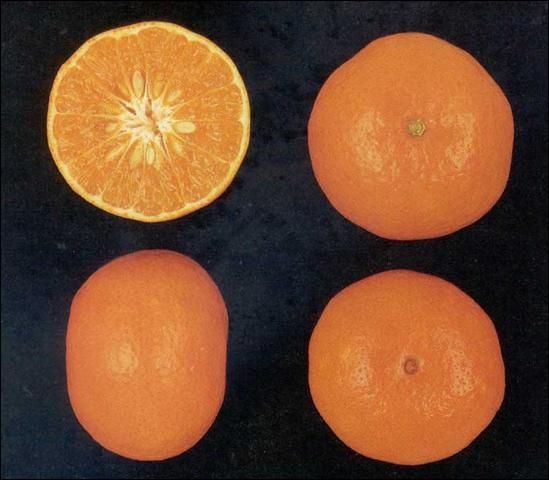The citrus hybrid Fallglo (Figure 1) is the result of a 1962 cross between Bower and Temple made by P. C. Reese. The plant was later selected for further evaluation by Reese and C. J. Hearn (both from the United States Department of Agriculture Horticultural Station in Orlando). Hearn released the variety in 1987.

Credit: UF/IFAS CREC
The parentage of this hybrid is very complex since Bower is a tangerine x tangelo hybrid and Temple is probably a tangerine x orange hybrid. The genetic makeup would then be 5/8 tangerine, 1/4 orange and 1/8 grapefruit. The variety is most like a tangerine and has been classified as such for marketing.
Fruit Characteristics
Fallglo fruit are fairly large and are usually 2¾ - 3¼ inches in diameter. The fruit shape is somewhat flattened with a small depressed navel as is the case with most tangerine types. The rind surface is smooth and about 1/8 to 3/16 inch thick. The peel color is a deep reddish orange at maturity. The fruit is somewhat easily peeled and usually contains between 20 to 40 seeds. Pollenizer trees are not necessary to ensure fruit set. The fruit matures in the late September-early November period with optimum palatability occurring around Thanksgiving. Degreening fruit may present special problems that can compromise shelf life.
Tree Characteristics
Fallglo trees are moderately vigorous, thornless, and more upright than Temple. They are apparently only moderately cold-hardy, a trait shared with the Temple parent. Fallglo is resistant to scab fungus disease, unlike some other citrus hybrids. The variety is quite susceptible to aphids and often suffers from a twig and limb dieback after planting. The foliage tends to be lighter in color and smaller in size vs. typical orange cultivars such as Hamlin and Valencias. Since this variety is relatively new, there is much to be learned about the performance of Fallglo over time.
Cultivation
Fallglo should perform as would most other citrus trees and should do well on most of the commonly available rootstocks. Lack of experience with the variety may turn up new problems but the only minor problems noted to date are listed below.
- Trees occasionally suffer from a limb and twig dieback of unknown origin.
- Trees are not particularly cold-hardy and should not be planted in historically cold locations.
- Aphids may be a troublesome pest on young trees, necessitating extra sprays.
- Limited data exist but many feel that this variety could be an acceptable pollen source for cross pollination with such varieties as Sunburst.
More Information
Hearn, C.J. 1987. "The Fallglo Citrus Hybrid in Florida." Proc. Fla. State Hort. Soc. 100:119-121.
Saunt, James. 2000. Citrus Varieties of the World. Sinclair International Limited, Norwich, England. pp. 63-64.